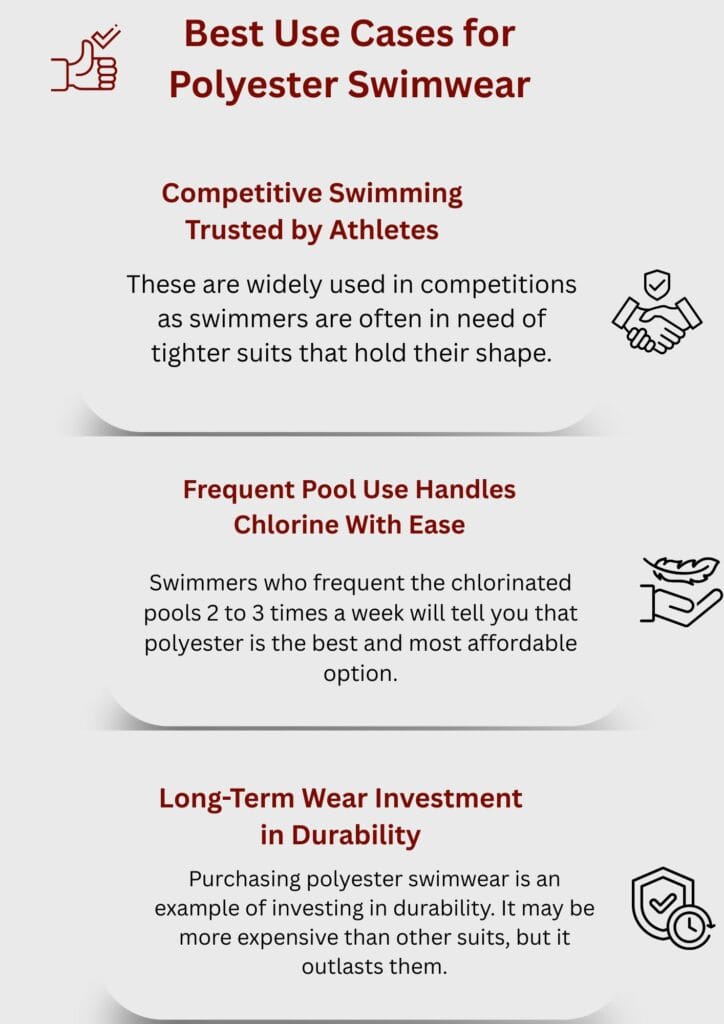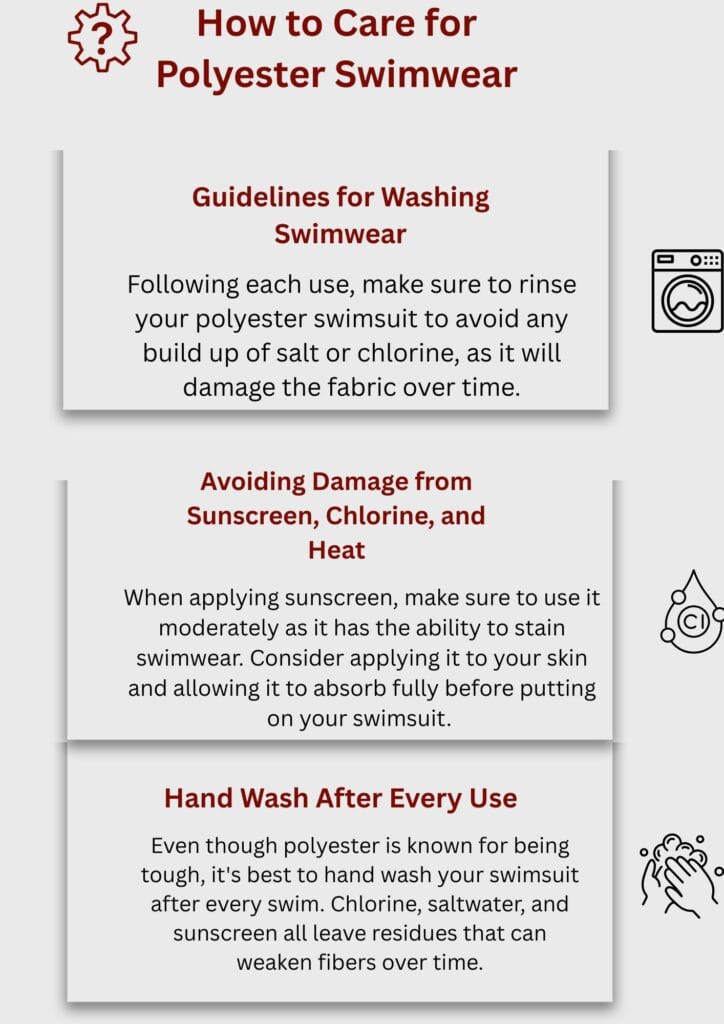Introduction
Polyester remains one of the most common synthetic fibers used in clothing. Its production comes from weathered logistic materials and, like any synthetic piece of ud in the market, has its merits. Polyester is praised for its durability and strength, making it an unquestionable favorite used in most swimwear products. is polyester good for swimming
Because of its unique characteristics, the answer to the metal question ‘Is polyester good for swimming,” is Yes. Polyester has proven to be widely beneficial for swimmers. This is due to its resistance to two major swimsuit attackers, chlorine and UV rays. It is also infamous for retaining its shape for long periods of time. These advantages of polyester ensure that it remains the fabric of choice, especially for serious swimmers.
In the following text, let´s take a look at its advantages and disadvantages so that we can firmly cement our position when it comes to swimsuit choices.
Pros of Polyester for Swimming
Chlorine Resistance – A Long-Lasting Choice
Due to the nature of swimming pools, one of the largest advantages of polyester is its high level of chlorine resistance. The use of chlorine in swimming pools is to ensure cleanliness and sterilization, however it comes at a cost when it comes to fabric durability.
Therefore polyester swimwear can keep its color and shape for a much longer time when compared to others like spandex or nylon. Because of its strength end users like swimmers who use pools frequently tend to prefer polyester, especially when compared to other materials. It does not degrade or sag with repeated use like most other materials.
Durability – Built to Withstand Use and Time
Polyester is a good choice for swimming because of its extreme durability. Tough and resilient, polyester fibers resist wearing, abrasions, and retain their shape even after frequent washes.
Regular swimmers, lifeguards, and those who participate in aquatic fitness activities will benefit from polyester swimsuits. Polyester is ideal for swimming both in chlorinated pools and in natural waters. Polyester is one of the most durable fabrics in the market today because of its ability to resist fading, stretching, and pilling.
Quick-Drying – Ideal for Everyday Swimmers
Compared to cotton and other natural fibers, polyester dries much faster. For those who frequently jump in and out of the pool, this is a major benefit. Drying fabrics help to manage the uncomfortable sensation of wetness and skin irritation after swimming.
Swimmers who train multiple times a day prefer fabrics that dry quickly. Avoiding discomfort, skin irritation, and mildew and odor are ensured. During travels or in humid climates, the fast drying feature of polyester is a significant advantage.
UV Protection – Safety in the Sun
Polyester is a multifunctional fabric that also provides better UV protection in comparison to other fabrics. UPF technology, which adds an additional layer of protection, is also used by many brands to enhance their swimsuits.
Outdoor pools can be a source of skin damage from prolonged sun exposure. However, swimwear made of polyester with a UPF rating of 50+ block out approximately 98% of harmful ultraviolet rays. Such swimwear is ideal for surfers, water sports fanatics, and beachgoers.
Eco-Friendly Options – Recycled Polyester in Swimwear
The production of swimwear from recycled plastic bottles and other PET waste has given rise to environmental concerns, categorizing them as rPET. Many eco-conscious swimwear brands have embraced this change and now offer suits made from recycled polyester.
The use of recycled polyester does not change its regular polyester advantages, but with a lower environmental footprint. Sustainable swimwear does not mean a compromised performance.
Cons of Polyester for Swimming
Less Stretch – Less Flexible than Spandex
One of the downsides of polyester fabric is the limited stretch it offers. Unlike spandex or elastane, which offer significant stretch, polyester is relatively inelastic. This may pose challenges in comfort or swim.
Competitive swimmers sometimes appreciate the firm fit and control a suit offers. Casual swimmers may appreciate the polyester suit’s features, but they may not enjoy the soft bendable feel. Polyester swimwear may feel more constrictive during movement, and may not hold up well over time.
Comfort & Fit – Not Polyester’s Strong Suit
Cost-effective polyester swimsuits, while durable, may come at a rough, chafing over time.
While polyester swimwear merges with other softer materials, it may balance comfort and durability. But alone, polyester may lack the softness and gentleness other materials offer.
Heat Retention – Retaining Heat More Than Other Materials
Compared to nylon or spandex, polyester retains more heat. This may impact swimmers during long swims or outdoor activities, especially in the heat.For hot weather activities, swimmers may prefer light, more breathable materials. For beach activities, hot climates, and especially for hot climates, swimmers often prefer lighter fabrics. The breathability of polyester isn’t practical for hot climates.
Polyester vs. Other Swimwear Fabrics
Polyester vs. Nylon – Durability vs. Stretch
Nylon is known for its smooth and elastic qualities. It’s a popular fabric for women’s swimwear and light recreational use. However, nylon breaks down quicker in chlorine and fades with wear.
Polyester outlasts nylon in both shape retention and color retention. So, when durability is key, polyester is better for swimming. For occasional wear, nylon swimsuits are great. For regular swimmers, polyester wins the long game.
Polyester vs. Spandex (Lycra/Elastane) – Flexibility vs. Longevity
Spandex offers unmatched flexibility and fits like a second skin. It does, however, lose its stretch over time, especially when subjected to chlorine and heat.
Polyester does not stretch as well, but does not break down as easily. Many modern swimsuits combine polyester with spandex for balance. Pure spandex suits may be comfortable, but if you want something that lasts, polyester is a smarter choice.
Polyester vs. Blends (Poly-Spandex) – Best Of Both Worlds?
Polyester-spandex combos are the most sought after blends. They provide flexibility, and durability. A typical blend might be 80% polyester and 20% spandex.
This combo works well for swimmers who would like comfort paired together with good durability. It is still able to stretch more than polyester and not lose endurance like spandex.
Best Use Cases for Polyester Swimwear

Competitive Swimming Trusted by Athletes
These are widely used in competitions as swimmers are often in need of tighter suits that hold their shape. Polyester suits are less prone to stretching, or fading with long term use.
Their durability, high performance polyester and poly blend swim suits are used. It is also why most major swimwear companies use these materials in their branded swimwear.
Frequent Pool Use Handles Chlorine With Ease
Swimmers who frequent the chlorinated pools 2 to 3 times a week will tell you that polyester is the best and most affordable option. It has the best chlorine resistance among all swimwear fabrics.
Because recreational swimmers tend to lose there swimsuits awfully fast, endurance swimmers, in shape water aerobics coaches, and fitness instructors often choose polyester swimwear. It is more affordable and durable compared to spandex.
Long-Term Wear Investment in Durability
Purchasing polyester swimwear is an example of investing in durability. It may be more expensive than other suits, but it outlasts them. If spending money on swimwear that constantly gets faded and stretched is not your cup of tea, then polyester suits will be a solid choice.
Purchasing swimwear made of polyester is a life smart decision, the polyester suits last a long time. Not to mention, they are eco friendly as well, as they recycle old materials and make new swimwear out of them.
How to Care for Polyester Swimwear

Guidelines for Washing Swimwear
Following each use, make sure to rinse your polyester swimsuit to avoid any build up of salt or chlorine, as it will damage the fabric over time. Use cold water combined with gentle soap to remove any remaining residue on the fabric.
You should never use harsh detergents or washing machines, as they will damage the fibers. Washing your swimsuit by hand will prevent fading and shrinking, which ensures that it will last longer.
Avoiding Damage from Sunscreen, Chlorine, and Heat
When applying sunscreen, make sure to use it moderately as it has the ability to stain swimwear. Consider applying it to your skin and allowing it to absorb fully before putting on your swimsuit. Also, avoid sitting on rough surfaces to prevent snags or pilling.
The use of dryers is never acceptable as it will cause damage to the fabric. Instead, you should choose the option of air drying your swimsuit in the shade to prevent fading.
Top Polyester Swimwear Brands
Reputable Brands Using Polyester
The brands that came first to the market of swimwear relied on polyester the most. Speedo, TYR, and Arena are known for their professional-grade swimsuits that are made to last and perform at the highest of levels.
Athletes and fitness swimmers appreciate their polyester swimsuits as they withstand chlorine, dry quickly, and retain their shape.
Sustainable Brands Using Recycled Polyester
Patagonia, Outerknown, and Finisterre are known for their sustainable swimwear. They do not compromise on performance, as they use recycled polyester and uphold eco-conscious standards.
These suits are effective and are made in an eco-friendly manner. For swimmers who are eco-friendly, these alternatives are some of the best.
Conclusion
So is polyester good for swimming? Yes, especially for those who value durability, chlorine resistance, and longevity. Although it may not be the softest or stretchiest, it performs well.
- Pick polyester swimwear if:
- You use pool facilities regularly
- You want a fabric that lasts a long time
- You require protection from UV rays and chlorine
For those who seldom visit the beach, value comfort, or prefer a more casual fit, a poly-blend may be the better option. However, if you seek consistent performance and wish to invest in long-lasting fabric, polyester remains unmatched.


